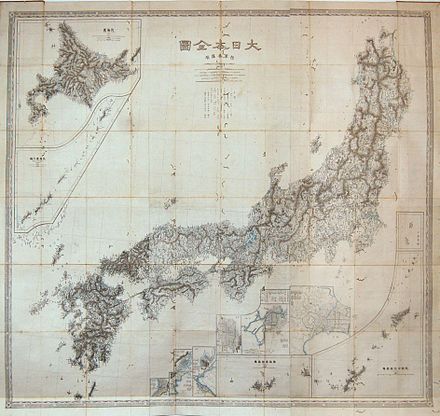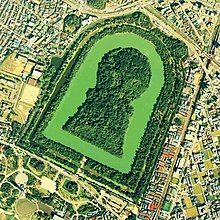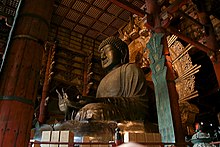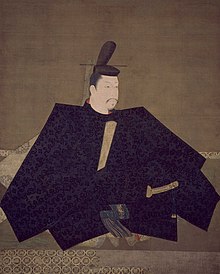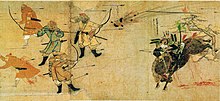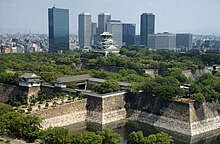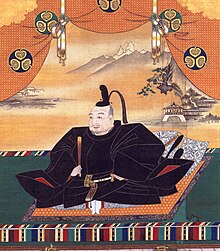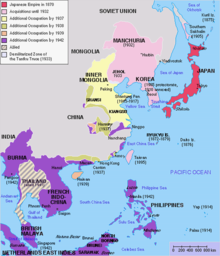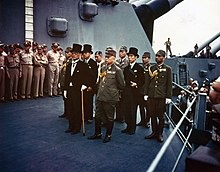History of japan
The history of Japan is shaped by an interplay of isolation and external influences. On the one hand, both the geographical remoteness and the self-chosen isolation from the outside world led to a spatially limited and self-contained development on the Japanese islands; Thus, according to some historians , the history of Japan is a model for the development from primitive civilization to modernity . On the other hand, China in particular shaped the culture and language of Japan through the spread of Buddhism and the teachings of Confucianism . Japan's history was also influenced in the west : after over two hundred years of isolation, the country was violently opened up and modernized in 1854. As a result, the Japanese Empire not only became the first Asian industrial nation , but soon sought to expand its sphere of influence in the Pacific region . Expansion ended with defeat in World War II and the occupation by United States troops. Today Japan is known as a technology-loving and, above all, globally active industrial state .
For a schematic representation of how the history of Japan is divided into periods, see the article on the periodization of Japanese history .
Early history
colonization
There is still no exact information about the time of the first settlement of the Japanese islands, it began about 30,000 years ago. The oldest human bone find was discovered in Okinawa , known as Minatogawa 1 . Presumably, people came to Japan from three regions:
- A group migrated from the area of today's Siberia over a land bridge from the Asian mainland to Hokkaidō . The migration of this so-called northern group is archaeologically and genetically well documented today (see Jōmon Volk) .
- A second immigration also took place over a land bridge from the Korean Peninsula to central Japan.
- The south of Japan was opened up by people from Southeast Asia by sea. These settlers were members of the Austronesian peoples .
The land bridges disappeared after the last cold period about 20,000 years ago.
Jōmon time
The semi-darkness of Japanese prehistory and early history is illuminated with the appearance of the Jōmon culture . The Jōmon period covers approximately the period from 30,000 to 300 BC. Its name is derived from the patterns created with cords and cords in the ceramics of that time; the oldest cord pattern ceramics in the world were found in Japan. The people of that time were hunters and gatherers , engaged in slash and burn, and lived together in loose associations. But early agricultural culture was also proven. Among other things, rice, grain, soy beans, pumpkins, hemp, perilla and adzuki beans were grown. Their accommodations were simple pit dwellings.
Today's Ainu show a ~ 80% genetic match with the Jōmon, followed by the Ryukyu populations with ~ 6–12% and the Yamato-Japanese with ~ 8%. The silk production, spinning and weaving are for the 1st millennium BC. To prove.
Yayoi time
The migration of the Proto-Japanese (Yayoi people) to Japan and their technical progress led to the transition to a new era, the Yayoi period (from around 400 BC to 300 AD). During the Yayoi period, wet rice cultivation and metal processing spread throughout Japan. Around 400 BC The wet rice cultivation came to Japan with new immigrants; the people gave up their semi-nomadic way of life and started farming. This period is named after the Tokyo suburb of Yayoi, where ceramics were found that were much simpler than those of the Jōmon period, but of higher quality. Apparently the manufacturers had gained technical knowledge. From the cultural stage of the Yayoi period with its village communities, the period of the first states in Japan emerged, among which Yamatai was the most powerful. The step towards the formation of the state introduces the Japanese antiquity.
Around 100 BC Chr. Conquered the Chinese Empire of the Han period , the Korean peninsula . The Chinese culture had moved close to Japan, and the foundations of an important cultural exchange in the following centuries were laid.
Today's Japanese show a 92% genetic match with the Yayoi and are therefore to be seen as direct descendants of those Yayoi. The ancient Yayoi subjugated and displaced the inferior Jōmon tribes almost completely.
antiquity
Kofun time
The Kofun period (around 300–552) is named after the keyhole-shaped barrows of that time, the Kofun . At that time, Chinese chronicles already mention a kingdom of Yamato on the Japanese islands, including five kings . In the 4th century this interfered in conflicts on the Korean Peninsula, where three empires ( Koguryo , Paekche , Silla ) fought for rule after the Chinese withdrew during the Wei period . During the Kofun period, there were lively relations with China and Korea , and cultural techniques were imported. Buddhism , which came to Japan in the 6th century, was essential . After violent conflicts it became the state religion (the Soga family gained considerable influence in this fight ). The following phase of Japanese history is called Asuka time after the capital of the time, Asuka-kyō , it begins around 592 and lasts until 710.
Asuka time
Although the Asuka period coincides with the Kofun period (552 marks the year Buddhism was adopted as the state religion), it is considered separately because the course for Japan's history was set during this period. The Soga established a rule that was far removed from the Buddhist ideal. Still, Suiko's accession to the throne (a niece of the Soga family head) ushered in a major change in Japan's history. Suiko's son-in-law, Prince Regent Shōtoku Taishi , was a devout Buddhist. In 604 he created the " 17 Articles ", a font for the ethical exercise of rule. He also adopted the Chinese system of court ranks, created an initial network of paths and ordered chronicles to be made. Although the following years were unfavorable for Japan, e.g. In Korea, for example, it came under military pressure from the strengthened China, followed by other major reforms. After Shōtoku Taishi's death in 622, there were severe political power struggles within Japan, which resulted in a coup of the Reform Party led by Naka-no-Ōe (Taishi's son) in 645. As a result, a series of laws were passed in 646, which should go down in history as Taika reform (Taika, Japanese for great turnaround).
The Taika edicts placed all land under the emperor, ordered the building of a capital, and ordered land surveys, censuses and taxation. With the Taiho decrees of 701, the reorganization of the Japanese Empire was completed. It was now a central state with a legal order built around the emperor. Due to the Japanese belief that every death pollutes the place of death, the residence had to be changed a few times during the Asuka period, but was most of the time in Asuka-kyō .
Nara time
Heijō-kyō ( Nara ) only became the capital for a long time in 710 . Japanese antiquity (also known as Japanese classical) begins. Overall, the Nara period was marked by peace and cultural prosperity. Danger threatened in the form of an invasion from China or Korea, but a conscription system guaranteed manned defensive walls. Otherwise, the achievements of the Asuka period secured the imperial court, which received tax income from a largely pacified and orderly country. However, new problems arose almost unnoticed by the rulers, because land came into the possession of monasteries and large families and the court was weakened.
These developments and Nara's unfavorable geographical location forced the capital to be moved to Heian-kyō (later Kyoto ).
Heian period
The Heian period (794–1185) is named after this city. At the beginning of the Heian period, Kammu- Tenno managed to stabilize imperial rule once again. But gradually the Fujiwara family managed to rule. The clan secured its influence through a clever marriage policy. It was only Emperor Go-Sanjō (accession to the throne 1068) who broke the rule of the Fujiwara, but at a high price. He went to the monastery and ruled indirectly from there, a practice that the imperial family then maintained for a while. But this procedure had severely weakened the imperial power and had lasting damage to the image of the imperial family. Literature and poetry flourished despite, or perhaps because of, the adverse conditions, so the Genji Monogatari was written in the Heian period. But the cultural bloom could not stop the decline of order. The emperor was no longer a powerful force of order; others took up the fight for rule.
The Japanese Middle Ages
The Japanese Middle Ages began with the disintegration of the central government, extending from 1185 to around 1600.
Kamakura time
The first phase of the Middle Ages is the Kamakura period from 1185 to 1333. Its central motif is the conflict between the Taira and Minamoto families . These warrior families had done police duties and campaigns for the court in Heian-kyō . With the collapse of order, the situation escalated into a struggle for rule between the two families. After the Taira had crushed the Minamoto, Taira no Kiyomori left the Minamoto leaders alive. A mistake with grave consequences, because under the leadership of the brothers Yoritomo and Yoshitsune, the Minamoto forces defeated the Taira. This conflict, known as the Gempei War , is a popular motif in Japan's literature, poetry, and film.
Yoritomo forced his brother to commit suicide after differences and then established the first shogunate in Kamakura . Parallel to the old imperial ruling structure, he established a tight, militarily organized administration. Logically, his government was also called Bakufu , which roughly means tent government and indicates the military nature of the leadership. After Yoritomo (who, according to the legend, died after falling from a horse caused by the ghost of his brother Yoshitsune), two of his sons ruled, but power then shifted to the Hōjō family .
The rule of the Hōjō
Under their leader Masako (1156-1225) a relatively peaceful state was achieved again. But there was danger from outside: In 1274 and 1281 there were attempted Mongol invasions in Japan . The government knew about this threat and built a rampart on Kyūshū to counter the invasion. However, Japan's armed forces would probably not have been able to stop the Mongols . But both times violent storms came to the aid of the defenders of the island empire and dispersed the invading fleets. This was the origin of the term "god wind" or kamikaze .
The defense of the attacks by the Mongols destabilized the rule of the shogunate considerably. Although the immediate threat was over, there was no way of rewarding the vassals who had provided troops and occupied the fortifications. Usually, in internal Japanese wars, the victors received the lands of the defeated families as remuneration. However, there was nothing to conquer among the Mongol attackers, so resentment spread.
In 1333, Kamakura-Bakufu ended with the destruction of the Hōjō by troops from the Ashikaga and Nitta families . At the instigation of Emperor Go-Daigo, these had taken to the field against the Shogunate, which had previously completely disempowered the emperors and sent them into exile. Go-Daigo hoped to regain power with the help of the Ashikaga.
Muromachi period

Unlike planned, however, the Ashikaga built a new shogunate and initiated the Muromachi period (1333–1568). Muromachi was a district of Heiankyo, there, in the old capital, the Ashikaga had also appointed an emperor they liked. This created a temporary schism for the imperial line as Go-Daigo stuck to his claim. In 1392, however, Go-Daigo's successor abandoned this request.
The Ashikaga rule came to an abrupt end. After a brief high phase under Ashikaga Yoshimitsu (who even Ming - China recognized as the ruler of Japan), the shogunate fell apart in the Ōnin War (1467-1477). This conflict raged in the capital and led to its almost complete destruction. With the capital, the central power was finally smashed.
The time of the warring states
Japan was a patchwork of rulers of individual princes and families. The following bloody and eventful times saw the arrival of the Portuguese in Japan, who also brought the first firearms with them and attempted Christian proselytization in Japan (cf. Christianity in Japan ). Despite all the turmoil and violence of the period known as Sengoku-jidai (Warring States Period), trade relations between the individual regions also developed. The firearm, which underwent no further technical development, would become important a few decades later in the Battle of Nagashino .
The end of the civil wars did not become apparent until the Azuchi Momoyama period (1568–1600). It was the time of the three unified empires, Oda Nobunaga , Toyotomi Hideyoshi and Tokugawa Ieyasu . Oda Nobunaga, a small daimyō from Owari Province , gained influence over the whole of Japan through skillful tactics, military talent and brutal will to assert himself.
Toyotomi Hideyoshi, who started out as a simple soldier in Nobunaga's army, continued his work of unification, with his attempt to invade Korea in 1592 cost the lives of more than 200,000 men. It is disputed whether he did not primarily send potential troublemakers to this military adventure. Above all, he pushed Japan's unification with diplomatic skills.
After Toyotomi Hideyoshi's death in 1598, Tokugawa Ieyasu emerged from the greats of the country. In the Battle of Sekigahara in 1600 he defeated Ishida Mitsunari and became the absolute ruler of Japan.
The Tokugawa rule began Japan's early modern period, which lasted from around 1600 to 1868 and is also known as the Edo period , named after the capital Edo .
Edo period
The Tokugawa ruled as shoguns equipped by the emperor with extensive powers and as the most powerful princes over the approximately 250 other Japanese princes ( daimyō ), who were largely autonomous in their respective domains (unofficially and pejoratively called Han ) and of whom about a quarter were in the in Edo- resident government apparatus of the Tokugawa (the Bakufu ) was involved in various functions. The third constant of the political system was the imperial court in Kyoto .
Class system
The imperial court was completely excluded from the exercise of power and isolated. According to the Confucian model, the population was theoretically divided into the four classes, which were also known in China and Korea: warrior-scholars, farmers, artisans and merchants ( shi-nō-kō-shō ). Changing the booth was almost impossible. In practice, however, social status was more important than belonging to a class: in each class there were numerous differentiations, not least of which were based on economic assets. The samurai mostly no longer managed the property belonging to them or assigned to them themselves, but performed civil and military services in the castle towns of their masters. They were only allowed to carry out a few commercial activities and were mostly dependent on the income from their official and pension loans.
As in China and Korea, the early modern rulers of Japan also sought thorough control of their subjects for fear of social instability and unrest. Farmers, craftsmen and traders were excluded from political office and decisions. However, they were expected to manage their own affairs within the framework of local and class self-government. Belonging to a professional organization was a prerequisite for an honorable life. In Japan, the household - mostly identical to a nuclear family, in the case of the higher status groups as a community of descent comparable to the whole European house ( ie ) - was the smallest social unit and community of responsibility. In the villages and urban residential areas, several households were bundled into groups that took part in the administration and control of the village or residential area. Misconduct by one member of the community often resulted in punishment for the whole group. Anyone who was excluded from their status for serious offenses was considered homeless and largely without rights and found themselves at the bottom of society.
External relations
Problems with piracy and the aggressive advance of Western powers led to drastic restrictions on overseas trade throughout East Asia at the end of the 16th century. The Tokugawa concentrated trade with China and Europe in the city of Nagasaki . Their only European trading partners were the Dutch, who had a trading post on the artificial island of Dejima . Over time, through translations, one got to know Western ideas and concepts that were conveyed through the new Rangaku (Dutch Studies) . Diplomatic and trade relations with Korea were maintained by the Principality of Tsushima . The Principality of Matsumae on the island of Ezo maintained contacts with the Ainu and indirectly through them to Russia , while the Principality of Satsuma held the kingdom of the Ryūkyū Islands, which had long been a hub of Pacific trade .
Society and culture
The Edo period is characterized by increasing urbanization and the penetration of market economy principles in most areas of life. The merchants and traders ( chōnin ) who lived in the cities created their own bourgeois lifestyle. The samurai, who also settled in the cities, became dependent on merchants because of the high costs associated with this lifestyle; they were often highly indebted. Even the daimyo were often forced to take out loans. The Japanese culture and aesthetic sensibilities were shaped more by the warrior class since the end of the Heian period. Conservative styles in architecture and literature, the aesthetic sense of Zen , the classic Noh theater and various ritualized acts (for example the tea ceremony popular among the bourgeoisie ) determined the picture. However, with increasing prosperity and increasing education, the bourgeois townspeople developed their own culture, characterized by rapidly changing fashions, which led to the emergence of entertainment districts in the big cities. The well-known paintings of the ukiyo-e and the kabuki as a new form of theater and numerous new musical styles should be emphasized .
The end of the Tokugawa era


The final phase of the Edo period is also known as the Bakumatsu period . Since the end of the 18th century, western powers have increasingly demanded access to Japan and its markets, above all Russia , England and the USA . In the middle of the 19th century there were peasant revolts, many samurai were in debt. The shogunate was increasingly losing control. In 1853 American ships (" black ships ") landed under Commodore Matthew Perry in the Bay of Edo to obtain concessions from the shogunate and the opening of contract ports . After four years of tough struggle, Shogun Tokugawa Iesada finally gave in, and trade relations between the United States and Japan came about for the first time in the Treaty of Kanagawa . The surrender of the Shogun led to strong resistance from various principalities against the rule of the Tokugawa and against the Europeans who had come into the country, who found their expression in the Sonnō jōi movement ("Worship the emperor, drive out the barbarians."). The Shogun and his followers were no longer able to suppress this movement politically and militarily. This led to the Meiji Restoration at the beginning of 1868 , which ended the rule of the Tokugawa in the name of Tennō.
Japanese Empire
From the Meiji Restoration in 1868 to the end of World War II in 1945, Japan was an empire ruled by the Tenno . These 77 years were the time of imperialism and colonialism .
Meiji period

Extensive reforms were introduced during the Meiji period under Emperor Mutsuhito . The class system was abolished, taxes in cash instead of in kind were introduced, and a conscript army was set up. After the Meiji Restoration , political power was officially reassigned to the Tennō, with the actual power being held by former samurai, the so-called Meiji oligarchs . With the Satsuma uprising of 1877, feudalist forces undertook a rebellion, but it failed.

Inspired by the Iwakura Mission , a study trip by high-ranking politicians to North America and Europe, the country was given a constitution . Japan adopted the German civil code in almost unchanged form. It was to become a modern constitutional monarchy and to be able to meet the West on an equal footing through rapid technological development, which was also achieved very quickly. Explosive economic growth and efficient arms policy made the inferior island kingdom a power factor in Asia. In 1895 Japan won a victory over China in the struggle for supremacy in Korea ( Sino-Japanese War ) and in 1905 Japan's navy defeated the Russian armed forces in the sea battle at Tsushima ( Russo-Japanese War ).
With the death of Emperor Mutsuhito in 1912, the Meiji period ended. The restoration of the imperial rule and the economic, social and military reorganization of the country in this era mark Japan's entry into the modern age. The " unequal treaties " imposed on Japan in 1855 or the extraterritoriality of the contract ports could have been repealed as early as 1894/1911.
Japanese imperialism

On November 17, 1905, Korea became a protectorate of Japan; it was officially annexed in 1910 ( see: Korea under Japanese rule ). The Manchuria came under Japanese influence, but which up to the Manchurian crisis was limited to the economic exploitation of Manchuria and also the construction of the South Manchurian Railway served.
In the First World War , Japan fought on the side of the Allies and benefited economically (see Japanese war aims ). According to the Versailles Treaty, it took over or annexed the German colonies in China , which led to massive protests in China ( Movement of May Fourth ). From around 1929/1930, Japan was hit hard by the Great Depression. The economy was restructured and heavy industry and influential financial groups ( zaibatsu ) emerged in the 1930s. These groups had a keen interest in rearmament and further expansion .
Japan tried to gain a foothold in Siberia in 1918 . The October Revolution was followed by international interventions on the side of the anti-communist resistance (“ White Army ”). 70,000 Japanese and 9,000 US troops landed at Vladivostok ; Japan held Vladivostok, parts of the Pacific coast and areas along the Trans-Siberian Railway in the Far Eastern Republic . In 1920 the Japanese interveners who remained alone with the troops of the Belarusian general Semyonov were pushed back into Vladivostok and the coastal strip, and Vladivostok was not recaptured until October 25, 1922. This failure sparked uprisings in Japan that triggered a change of government into the bourgeois camp.
From 1912 to 1926, the Taishō -Tennō Yoshihito, a mentally ill man, ruled, which shifted power from the Tennō and his confidants, the Genrō , to parliament and the newly founded parties.
In 1926 the Shōwa period began with Hirohitos enthronement . He ruled a country in which nationalist forces gained increasing influence since the end of the First World War. Japan had not been treated equally in various international negotiations, particularly in the Portsmouth Treaty . His claim in Korea was recognized (despite protests), but Japan's plans to expand in China found no support in the West. The global economic crisis , natural disasters such as the destruction of Tōkyō by an earthquake in 1923 and social problems led to a political radicalization of the country. After the attempted coup on May 15, 1932 , the Saitō cabinet began the era of the “ cabinets of national unity ” and massive persecution of socialists. After an attempted coup in February 1936 , Hirota Kōki became Prime Minister. An ultra-national group made up of the military gradually seized power.
The Tennō and his divine ancestry were moved to the center of political ideology, other than the ultra-national opinions were persecuted. In 1940 the multi-party state was dead, a central organization called Taisei Yokusankai took over all functions. The military had already operated in China without political influence - for example in Manchuria ( see: Manchukuo ).
On March 27, 1933, Japan withdrew from the League of Nations following the negative report by the Lytton Commission . In 1937 the incident at the Marco Polo Bridge sparked the Second Sino-Japanese War . Troops of the Imperial Japanese Army committed drastic war crimes (" Nanking Massacre ") after the capture of the Chinese capital Nanking in 1937/38 . Japan linked its aggressive expansionist efforts with the Axis powers Germany under Hitler and Italy under Mussolini . Embedded in the Berlin-Rome-Tokyo axis and a non-aggression pact with the Soviet Union (1941), the military began a campaign of conquest in East Asia under the motto Asia for Asians , which collapsed the colonial empires of the Netherlands , the United Kingdom and the USA within a few months . Japan replaced this with the so-called " Greater East Asian Prosperity Sphere ".
Japan in World War II
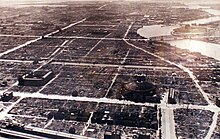
The attack on Pearl Harbor in late 1941 implied formal entry into World War II . Japan achieved success in the occupation of China and was able to expand its sphere of influence throughout Southeast Asia; even Australia was considered threatened. In the course of these military successes, Japanese troops committed atrocities in the occupied territories; they used biological and chemical warfare agents and made human experiments on prisoners of war (see also Japanese war crimes in World War II ).
Japan ruled the Philippines , New Guinea and Burma as well as countless island groups; with Indonesia , an oil-rich country had become a colony of the empire. It was not until the Battle of Midway in June 1942 that the tide turned in the Pacific War . The Japanese Navy lost four aircraft carriers. In August 1942 the Japanese lost another important battle at Guadalcanal .
The imperial army was widely spread across the vast empire, and its supplies were susceptible to attacks by submarines. The imperial army was able to hold out well until 1944. With the increasing arrival of troops from the European theater of war and from the United States, the Allied counter-offensive began to roll. Southeast Asia was gradually liberated; US forces moved toward the main Japanese islands in a series of amphibious operations known as island hopping .
Despite bitter resistance, the most important defensive positions of the Japanese armed forces fell in 1945 in the battles for Iwojima and Okinawa . Despite this hopeless military situation and permanent bombing, the Japanese military were not ready to declare unconditional surrender . A little later the controversial atomic bombs were dropped on Hiroshima and Nagasaki (August 6 and 9, 1945), and the Soviet Union declared war on Japan on August 8, 1945. These events forced the unconditional surrender of Japan ; Emperor Hirohito announced it in a radio speech on August 15.
State of Japan
After defeat in World War II in 1945, Japan was transformed into a democratic state. Peace has reigned in Japan since the capitulation of Imperial Japan , and Japan has become a state with significant economic strength.
Occupation time and new beginning
From 1945 to 1952 Japan was occupied by the Allies (de facto the United States ). The Potsdam Treaties reduced Japanese territory back to the main islands, and the Ryūkyū Islands became US territory (and remained so until 1972).
Extensive democratization and demilitarization efforts were carried out during the period of occupation, led by General Douglas MacArthur , commander in chief of the Pacific Forces. This allowed the Communist Party to operate legally for the first time. In the course of the Cold War , however , it was switched off again shortly afterwards by a political cleansing , the Red Purge .
The emperor was spared an indictment in the Tokyo trials and part of the old elite was called in to establish a new social order. Although this approach led to the establishment of a stable new state structure (while retaining the empire as a supporting element), it also led to a lack of processing of the incidents and crimes of war.
Unlike in Germany, this topic was and is taboo in Japan and the guilt of a small group of military officials was blamed. All in all, however, the renewal of Japan was a success; large corporations that had earned money from the war were smashed, and a new constitution that made democracy and peace its central themes came into force in 1947. Reforms in the school and university system should remove the remnants of the ultra-national harmonization. With regard to the armed forces, the constitution stipulated that only self-defense forces could be maintained. The US and Japan have since been linked in a security pact that obliges the United States to support Japan. In 1951, 48 states officially made peace with Japan again in the peace treaty of San Francisco ; the occupation ended in 1951/52.
From 1952 until today

In 1956 the Soviet Union and the People's Republic of China ( see: Sino-Japanese relations ) reestablished diplomatic relations and a rehabilitated Japan became part of the United Nations . 1955 established a stable system of two parties, the Liberal Democratic Party (LDP) and the Socialist Party of Japan . The political structure thus resembled that of numerous Western democracies. With the entry into force of the Basic Treaty between the Republic of Korea and Japan on December 18, 1965, diplomatic relations with South Korea were normalized.
The country now remained cautious about foreign policy , but its economic rise was unstoppable. Automobile and shipbuilding, later electronics, became the industries whose exports fueled Japanese economic growth from 1960 to 1970. Japan was accepted into the group of G8 countries. In 1985, the yen , which had previously been separate from the foreign exchange market, was released, and the yen appreciated against the US dollar . This development dampened the Japanese economic development, since the USA was and is the main sales market for Japanese exports.
In 1989 Emperor Hirohito died. His son Akihito became emperor in 1990 and the Heisei period began , which was overshadowed by the bursting of the bubble economy from the start . Japan did not calm down in the following decade. The economy fell into a deep crisis and several governments and prime ministers failed. In 2000/2001 the situation stabilized for the first time. The government of Prime Minister Jun'ichirō Koizumi , elected in 2001 , was in power until September 2006. Koizumi's successor is his former political pupil Shinzō Abe . After internal stabilization, starting with the UNTAC mission in 1992, Japan is now also active around the world within the framework of United Nations peacekeeping measures .
2011 was the first time in the history of Japan Nuclear emergency declared after the Fukushima nuclear power plant I due to a severe earthquake of magnitude 9 an incident had occurred.
See also
- Japanese economic history
- Japanese colonies
- History of the Japanese seafaring
- Periodization of Japanese History
- List of special historical places of Japan
literature
- Roger Bersihand: History of Japan. From the beginning to the present. Alfred Kröner Verlag, Stuttgart 1963.
- Hans A. Dettmer: Basic features of the history of Japan. Scientific Book Society, Darmstadt 1992, ISBN 3-534-01368-9 .
- Danielle Elisseeff: Histoire du Japon. Entre Chine et Pacifique . Editions du Rocher, Monaco 2001, ISBN 2-268-04096-8 (French).
- John Whitney Hall et al. a. (Ed.): The Cambridge History of Japan. 6 volumes. Cambridge University Press, Cambridge 1988-1999 (English).
- Vol. 1. Ancient Japan. Edited by Delmer Brown (1993)
- Vol. 2. Heian Japan. Edited by Donald Shively and William H. McCullough (1999)
- Vol. 3. Medieval Japan. Edited by Kōzō Yamamura (1990)
- Vol. 4. Early modern Japan. Edited by John Whitney Hall and James McClain (1991)
- Vol. 5. The Nineteenth Century. Edited by Marius Jansen (1989)
- Vol. 6. The Twentieth Century. Edited by Peter Duus (1988)
- John Whitney Hall : The Japanese Empire (= Fischer World History . Volume 20). Fischer paperback, Frankfurt am Main 1968.
- Kenji Hirashima: The reform policy in Japan and Germany in comparison. Research Center Japan, Osnabrück 2005 ( PDF ).
- Kiyoshi Inoue: History of Japan. 2nd, revised edition. Campus Verlag, Frankfurt / New York 1995, ISBN 3-593-34845-4 (3rd edition. Parkland Verlag, Cologne 2001, ISBN 978-3-88059-994-9 ).
- Seiichi Iwao: Dictionnaire historique du Japon. Editions Maisonneuve et Larose, Paris 2002, ISBN 2-7068-1633-3 (French).
- Josef Kreiner (Ed.): History of Japan. 6th, updated and expanded edition. Reclam, Stuttgart 2018, ISBN 978-3-15-019574-1 .
- Christine Liew : History of Japan. Theiss, Stuttgart 2012, ISBN 978-3-8062-2542-6 .
- Manfred Pohl : History of Japan. (= CH Beck Wissen . No. 2190). 5th, updated and expanded edition. Beck, Munich 2014, ISBN 978-3-406-66440-3 .
- George Bailey Sansom: A History of Japan. 3 volumes. London 1959–1964 (English).
- George Bailey Sansom: Japan. From early history to the end of the feudal system. Magnus, Essen 1975, DNB 750489626 .
- Michael Schaper (Ed.): The Imperial Japan. (= GEO epoch. No. 21). Gruner + Jahr, Hamburg 2006, ISBN 978-3-570-19556-7 .
- Reinhard Zöllner : History of Japan. From 1800 to the present. 3rd, updated edition. Schöningh, Paderborn 2013, ISBN 978-3-8252-3934-3 .
Web links
- Japan story . In: Laender-Lexikon.de
- Japan story . In: JapanDigest.de
- Japan story . In: Japanlink.de
- Japanese historical periods . In: Website of the Institute for the Cultural and Intellectual History of Asia
- Japan - the mysterious empire . In: Spiegel Online ( Spiegel Geschichte 5/2011)
- Ancient Japan ( Memento December 10, 2008 in the Internet Archive ). In: Wsu.edu (English)
- Japanese History . In: Japan-Guide.com (English)
- Digital copies of Japanese libraries and universities on history and culture - portal of the eLibrary project (eLib)
Individual evidence
- ↑ see also: Old Maps from Japan
- ^ RHP Mason, JG Caiger: A History of Japan . revised edition. Tuttle Publishing, 1997, ISBN 0-8048-2097-X , pp. 20 ( online at Google Books ).
- ↑ Hideo Matsumoto: The origin of the Japanese race based on genetic markers of immunoglobulin G . In: Proceedings of the Japan Academy, Series B . tape 85 , no. 2 , 2009, ISSN 0386-2208 , p. 69-82 , doi : 10.2183 / pjab.85.69 ( online [accessed on July 20, 2018]): “The results of a population study by Bannai et al., (22) who analyzed HLA polymorphisms, suggested that the Ainu might share the same ancestor in eastern Asia with native Americans (Tlingit and Amerindians). Their findings indicate that the indigenous Japanese people, ie, the Ainu, belong to the northern Mongoloid group, and are in good agreement with our results that the Ainu have the northern Mongoloid Gm genes at higher proportions than the present-day Japanese people . "
- ↑ Jomon genes: using DNA, researchers probe the genetic origins of modern Japanese - Cover Story | Science News | Find Articles at BNET. January 22, 2011, accessed on March 12, 2019 : “In conjunction with other historical evidence, the new work suggests that the Jomon did not originate in Southeast Asia, as one long-standing theory has it, but farther north. The research also sheds light on the extent to which the Jomon and the Yayoi have influenced the genetic makeup of modern Japanese. "
- ^ Javanese influence on Japanese - Languages Of The World . In: Languages Of The World . May 9, 2011 ( online [accessed July 25, 2018]).
- ↑ Dieter Kuhn : New Fischer World History: East Asia to 1800 . Fischer, Frankfurt am Main 2014, ISBN 978-3-10-010843-2 , pp. 68 .
- ^ RHP Mason, JG Caiger:. revised edition. Tuttle Publishing, 1997
- ^ Dieter Kuhn: East Asia until 1800 . Fischer, Frankfurt am Main 2014, p. 70 .
- ^ Crawford, Gary W. (2011). "Advances in Understanding Early Agriculture in Japan". Current Anthropology . 52 (S4): S331-S345.
- ↑ Matsui, A .; Kanehara, M. (2006). "The Question of Prehistoric Plant Husbandry During the Jomon Period in Japan". World Archeology . 38 (2): 259-273.
- ↑ Crawford, GW (1992) "The Transitions to Agriculture in Japan." In Transitions to Agriculture in Prehistory , edited by AB Gebauer and TD Price, pp. 117-132. Madison: University of Wisconsin Press.
- ↑ a b Takashi Gakuhari et al .: Jomon genome sheds light on East Asian population history . 2019, bioRxiv : 2019/03/15/579177 ( Preprint - full text): "The range of admixture fractions with good model fit is generally quite wide, with best fit models show IK002-related contributions of 8%, 4% and 41% into Japanese, Devil's Gate Cave and Ami, respectively (Fig. S8). "
- ↑ Fumihiko Takeuchi, Tomohiro Katsuya, Ryosuke Kimura, Toru Nabika, Minoru Isomura: The fine-scale genetic structure and evolution of the Japanese population . In: PLOS ONE . tape 12 , no. 11 , January 11, 2017, ISSN 1932-6203 , doi : 10.1371 / journal.pone.0185487 , PMID 29091727 , PMC 5665431 (free full text).
- ^ Dieter Kuhn: East Asia until 1800 . Fischer, Frankfurt am Main 2014, p. 78 .
- ^ Dieter Kuhn: East Asia until 1800 . Fischer, Frankfurt am Main 2014, p. 79 f .
- ^ Rainer Achim Blasius, Ilse Dorothee Pautsch, Hans-Peter Schwarz, Martin Koopmann, Matthias Peter: Files on the Foreign Policy of the Federal Republic of Germany, 1971 . Oldenbourg Wissenschaftsverlag, 1971, ISBN 3-486-56618-0 , p. 53 (published on behalf of the Foreign Office by the Institute for Contemporary History )
- ↑ Die Zeit : Explosion in a Japanese nuclear power plant - Nuclear emergency declared on March 12, 2011
- ↑ Vol. 1. Ancient Japan, OCLC 457145728 (e-book)
- ↑ Vol. 2. Heian Japan, OCLC 457145736 (e-book)
- ↑ Vol. 3. Medieval Japan, OCLC 457145743 (e-book)
- ↑ Vol. 4. Early modern Japan, OCLC 715996349 (e-book)
- ↑ Vol. 5. The Nineteenth Century, OCLC 457145753 (e-book)
- ↑ Vol. 6. The Twentieth Century, OCLC 440769619 (E-Book)
